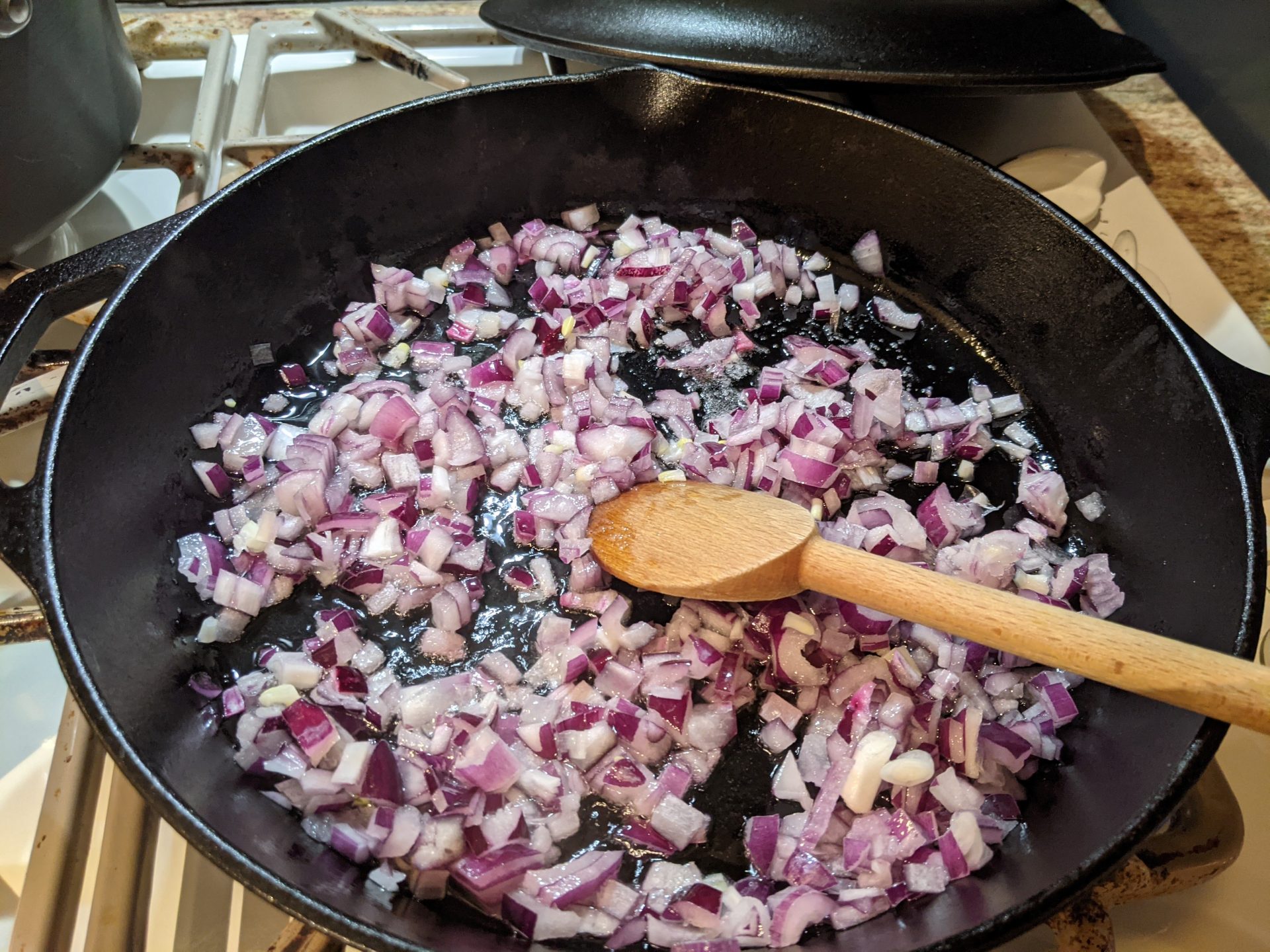
While it may officially be Spring, the weather is still quite chilly, damp and a bit dreary. Normally, I would cheer myself up by heading to the Art Institute or Museum of Contemporary Art, but until very recently these have been closed. And although you now can go to the museums, you have to think ahead and make reservations. So to brighten up our lives, I have been turning to Indian and Middle Eastern foods even more than usual. This Cashew Curried Chicken with its bright spices and herbs lend color to my otherwise somewhat dull existence. As mentioned in a previous post, I have become a fan of Chetna Makan and watch her on YouTube almost daily. This recipe is hers with some tweaks from me that do away with a pan, an extra step and the order of adding a couple of ingredients.
Do not be put off by the seemingly long list of ingredients. The spices are used over and over again in both Indian and Middle Eastern cooking. So if you enjoy these foods, you will easily use them up. And everything is readily available online or in many grocery stores these days. But because the spices and herbs are so integral to the dishes, please look for the freshest ingredients and grind your own spices whenever possible. It only takes seconds in a spice or coffee grinder and you will be rewarded over and over with the most vibrant flavors. And by buying whole spices, they will remain fresh longer in your cabinet.
Chicken thighs are used here. They are more flavorful than the breast, in my opinion, and almost never get dried out or tough. However, if you really want, you can use an equivalent amount of chicken breast meat instead.
This curry comes together easily and you can have dinner on the table in about an hour. Served simply over rice or with a flatbread, it’s a complete meal. Since my husband just made some delicious pita, we went with that. But if you have the time and add on a raita and some pickle, you can have a feast. So brighten up your life and enjoy this luscious and luxurious Cashew Curried Chicken soon.
Recipe

Yield: 4 to 6 servings, depending on appetite and sides
Ingredients
1/3 cup raw cashews, soaked for 1 hour in hot water to cover
2 medium onions, peeled and chopped in a fine dice
2 Tablespoons neutral oil with a good smoke point (I use Canola)
4 medium tomatoes, cored and roughly chopped
4 large cloves of garlic, peeled and grated or crushed
3-inch piece pf fresh ginger, peeled and grated
8 boneless, skinless chicken thighs – 2.5 pounds of boneless meat, trimmed of all fat. (You can use thighs with the bone-in, but you will need to increase the cooking time by 10 minutes.)
4 Tablespoons whole milk natural yogurt
1 sweet bell pepper, cut into large cubes
1 medium onion, peeled and cut into 8 pieces
1 Tablespoon fenugreek leaves (also called methi)
Spices

4 green cardamom pods
1 cinnamon stick
2 bay leaves (dried or fresh)
1 teaspoon cumin seeds
2 teaspoons ground coriander
2 teaspoons garam masala
1 teaspoon ground turmeric
1 teaspoon kosher salt
1 teaspoon chili powder
Directions
In a large, deep pan with a tight-fitting lid, heat the oil. Add the cardamom, cinnamon, bay leaves and cumin seeds. Allow everything to sizzle and become fragrant – about 30 seconds.

Now add the chopped onion and stir through the oil and spices. Cook until golden, stirring occasionally for 10 to 12 minutes.

Stir through the chopped tomatoes, garlic and ginger. Then cover the pan and on medium-low heat, cook for 10 to 12 minutes. The tomatoes should be softened and a sauce is beginning to form.


While the tomatoes cook, drain and crush the cashews into a paste using either mortar and pestle, food processor or spice grinder.
Turn off the heat! Now add the yogurt and crushed cashews and stir through, mixing well. By turning off the heat, you prevent the yogurt from splitting.

Stir through the coriander, garam masala, turmeric, salt and chili powder.
Nestle the chicken thighs into the sauce and coat with the sauce. Cover the pan and simmer for 20 minutes if using boneless chicken and 30 minutes if the thigh is on the bone. Add the bell pepper and onion sections and stir through. Recover the pan and continue simmering for 10 more minutes.
Take 1 tablespoon of fenugreek leaves and crumble them into the curry by rubbing the leaves between your hands. Cook for a few more minutes, stirring until they are fulIy incorporated. If you do not have fenugreek leaves, do not try to substitute them. Do NOT use fenugreek seeds, which would be very bitter. Fenugreek has a unique and wonderful flavor and I think they are worth having on hand. If you are leaving them out, you can sprinkle some fresh cilantro on top before serving. The flavor is completely different but is also delicious.
Serve the curry over basmati rice (white or brown) or eat it with flat bread.
For other delicious curry recipes:
Bene Israel Fish Curry with Fresh Ginger, Tamarind and Cilantro
















